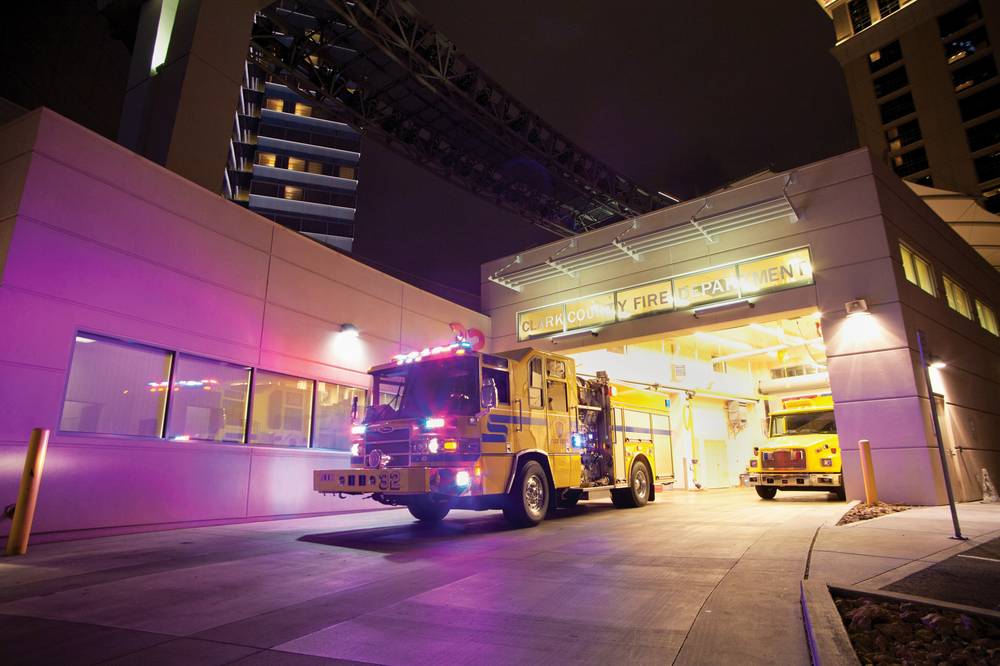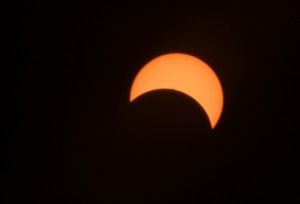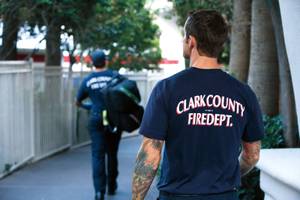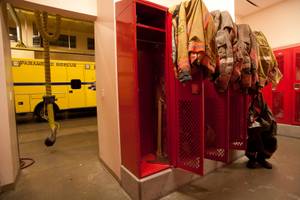You’re on an outdoor walkway near the center of the Strip. Hotels stab the sky all around you. From this perspective, they’re all unmarked architecture. There’s a metal staircase, and you can hear something heavy trudging up. Clung, clung, clung. The air smells like frying hamburgers, an odor from a vent you cannot see. Clung, clung, clung. You hear a buzzing overhead and look up to see a silver tram slide by. Then, the trudger arrives at eye-level, presumably human, clad in massive gear—heavy coat and boots, helmet, oxygen mask. It’s 100-something degrees. He turns around and starts clunging back down.
He’s exercising.
It simultaneously does and does not seem strange to have a fire station right smack on the Strip. Station 32 opened on December 10, 2009, at 2550 West Harmon Avenue. Technically, it’s part of CityCenter. More specifically, it’s connected to Vdara, with quick access to Las Vegas Boulevard from Harmon just west of Cosmopolitan’s parking garage entrance. It was the first Clark County fire station built on a resort property, and MGM Resorts paid for the facility’s construction and equipment. As part of the development agreement, MGM also paid for another paramedic rescue vehicle housed at a different station, bringing its total contribution to about $28 million.
At 5,700 square feet, Station 32 is smaller than most. The “barn” accommodates two vehicles: a rescue unit (basically a giant ambulance) and a modified, smaller fire engine. The engine is a marvel of efficiency and organization. It’s compact enough to flip a U-turn on the Strip, yet stocked with thousands of feet of hose, plus sledgehammers, ladders, saws and extinguishers—everything the crew needs. Tools are stacked and stashed in nifty little compartments all over the engine, making it seem like a big yellow Batmobile.
Six men work out of Station 32—a captain, two engineers and three firefighters. It was expected to be one of the busiest stations in the country, and it is, the majority of its calls medical in nature. Before 32 opened, Station 18, on Flamingo Road between Paradise and Swenson, took the majority of Strip calls and was the busiest in the country for years. For comparison’s sake, Station 18 has 13 guys, two rescue vehicles, a truck and a full-sized engine.
I arrive at 32 on a Friday at 8 a.m., and I’m immediately offered breakfast. It smells good—eggs, potatoes, bacon—but I skip the meal to take a tour from Scott Wintch and Mike Hellem, two firefighters who grew up in Las Vegas and trained together. Their rookie probation anniversary was a few days ago. Hellem graduated from Silverado High in ’08, Wintch from Centennial in ’06. They’ve both been at 32 for two months. “I knew what I was getting into here, and I didn’t have a choice,” Wintch says. His previous station in Henderson averaged eight calls a day. Tonight, he’ll get 10 in 12 hours. “This is pretty much the notorious one, where no one wants to go. But I like the faster pace. It’s good to end my rookie year here.”
Station 32 has become a training ground because of its high call volume. Capt. Mark Manganello, a no-nonsense type, is filling in for the usual captain today. “You’ve come on a day when there’s almost nobody here that’s usually here,” he says. He’s been on the job for 21 years and seen many different stations. “The thing that makes stations different is the guys. You get to know everybody, sometimes you do stuff as a crew off-duty. That’s what makes each station different; it’s not the building. You get a good group of guys, you can run all day and it’s no big deal. If you don’t like somebody, it feels like you’re ready to go home after your first call.”
Wintch and Hellem clearly love being here, no matter how busy and crazy it gets—because of how busy and crazy it gets. They show me around the station, pointing out how the kitchen and living room spaces are combined because everything is more compact at 32. Armchairs surround a seldom-used big-screen TV, and the captain’s area looks like a dorm room, a small, blue-carpeted office leading into a closet of a bedroom. There’s a room full of maps. And everywhere you look, there are monitors of different sizes mounted on the walls, constantly tracking information on emergency calls across the Valley. No matter what a firefighter is doing, including the rare instance of napping, he’s never far from this vital data.
There are three more dorm-style rooms with single beds for the firefighters and another set with an adjoining office for the engineers. Sheets are folded in neat stacks, not one bed made. Perhaps no one expects to sleep. In the hallway, there’s a bulletin board covered with badge-shaped patches from different fire departments all over the world. People walk by this place all day, many not realizing it’s a fire station, but once firefighters from other cities or countries find out about the station on the Las Vegas Strip, they want to check it out. Sometimes they leave a patch or swap T-shirts.
At the end of this hall is the “gym.” “It’s our gym/water heater/mop bucket storage,” jokes Wintch. The cardio room is particularly sad, barely big enough to contain an old treadmill. The crew also exercises by running those stairs out back in full gear, the ones that lead up to the Bellagio-CityCenter tram station.
Exercise is something firefighters are lucky to find time for at Station 32. Justin Ratliff, an engineer, has been here four months, and before that he worked out of the also super-hectic Station 18. As he runs down a typical day, I realize these guys get more done in one 24-hour shift than most of us do in a week—cooking, cleaning, training and responding to 15 to 30 calls every day.
“It’s not come in, eat steaks and play video games, but that’s what a lot of people think we do,” Ratliff says. “At this station, Thursday, Friday, Saturday, Sunday and Monday are pretty much nonstop. You might hit the bed 30 minutes the whole day.”
It’s midday and I’m standing out back with Ratliff, watching Wintch, Hellem and firefighter Jonathan McBreen perform ladder-throwing drills. Basically, they pretend there’s a fire, set a retractable ladder up against the station house, climb to the roof and go through the motions. Before stepping out on the roof, Hellem pounds it with a sledgehammer a few times. Details are important.
Ratliff is telling me it’s unusually quiet for a Friday, when the alarms go off. It’s nothing like the dinging bell you’re thinking of, and for that matter, no one slides down any poles. The alerts are loud and unmistakable, but not jarring enough to mess up your head or heart if you were sleeping. “They call them heart-saver tones,” Wintch says later. The system can also be set so specific rooms are alerted with lights and sound, while firefighters who wouldn’t respond can rest easy.
Manganello and engineer Mike Sachs jump in the engine with Wintch and Hellem, and they’re off. The crew moves too fast for me to even find out what this call is about.
At Station 32, you don’t know when the crazy will start or when it’ll stop. Medical classes, vehicle maintenance, working out and educational review are the reality behind the fantasy of steaks and video games. Firefighters work 24 hours and then get 24 hours off, but that’s more exhausting than it sounds. Off time is really just a series of naps, errands and exercise, and at Station 32, a 24-hour shift will likely include six or eight or 12 hours of response, return, response, return. Or maybe, there’s no return. Maybe you go from call to call all night, making sure the tipsy citizens of the Strip are in good care. After 10 days, five on and five off, they get six days off. It doesn’t seem like enough.
Sachs is a veteran, filling in today for someone else. “I was at Station 18, too, when it was the busiest in the nation, but this has overtaken it. A lot of guys [don’t want to be here]. These guys do it without blinking an eye, they’re used to it, but the call volume here is more than twice what the busiest nights are at the average station.”
Dealing with the ever-changing demands of the Strip is an additional challenge. The station is ideally situated so response times are remarkably fast, but that’s just the beginning. A large percentage of calls involve alcohol, which can often mask more serious medical issues, and tourists don’t know their way around, so they might call for help and say they’re near Caesars Palace when they’re actually somewhere else. Foreign visitors make for communication obstacles, and access can be an issue. Sachs says one casino used to be particularly bad about where emergency vehicles were allowed to arrive. “You could literally have a call at the front valet, but they wouldn’t want you pulling in there because it doesn’t look good. That’s a problem. We really addressed that we need to be brought to the closest appropriate place that has access to where the emergency is happening, and now it’s mostly been resolved.”
Manganello talks about the Manhattanization of Las Vegas, how higher buildings translate into a need for more emergency response. “The area for this station might not be that big, but it is when you consider how high you gotta go. It’s just dense, and the more people you have, the more times someone needs some sort of help. Wherever you go, people get intoxicated, people get hurt. It’s not that much different. It’s the volume.”
The two rookies remember a car fire in the parking garage at MGM Grand in early June. A car on the second level burst into flames, and the fire quickly consumed the two vehicles on either side, damaging several more. “It was our first cycle at this station, and we were on the engine, and there was a rookie from our class from 18 and one from 11 that came in, too,” Hellem says. “It was fun, because you’re fighting a fire with your friends and you don’t see too much of that as a rookie. But at 300 feet out we couldn’t see the situation [through the smoke].”
What is terrifying to you and me is routine for firefighters. No one was injured in that incident, and these guys were just glad it wasn’t an underground parking garage, where smoke is an unavoidable problem.
By late afternoon things are picking up. Three firefighters are attempting to make dinner, a chore reserved for the less tenured. McBreen is working on a salad, drying leaves of romaine lettuce, when the alarm sounds: car accident on West Flamingo. Before he and Ratliff are out of the driveway, the alarm sounds again for a second call.
“Always when we’re cooking,” Wintch says as he turns off the stove, stranding a pan of squash and zucchini in lukewarm limbo.
The station empties in seconds. When Ratliff returns from the accident, he shows me the computer system in the rescue, how crews can monitor where other response vehicles are and where the next call might be coming from.
“It’s a point of pride,” he says. “You want to handle your area. You don’t want other stations to have to handle your area.” On the Strip, that’s incredibly ambitious, but he knows that. And then, another call. An injury near Cosmopolitan. They’re off. This is why you’ll find a crockpot in most fire stations.
Dinner, eventually, is delicious. Grilled chicken, vegetables and salad dropped on big, fluffy pita bread with dill-yogurt sauce. It’s fresh and hearty and will hold up just fine if another call comes in—and it does. Even though it’s not shrill or startling, I’m getting tired of hearing the alarm, but the firefighters are ready and waiting for that sound, every single time.
Ratliff and McBreen roll out again, their departure interrupting a hilarious discussion about whether McBreen’s appearance in the annual fundraising firefighter auction will rake in bigger bids than Ratliff did last year. As soon as they’re out the door, the other firefighters cover their plates with foil.
In the moments between calls, there are lots of jokes. Even though this is a temporary team, these six get along well, and they all know how important that is. “If you gel with your crew, it don’t matter how busy you are,” Manganello says. “If you’re around this station, the volume alone is enough to wear down anybody. I’m too old to be here for any length of time. But everybody who’s here is happy to be working here. You choose to make a bad day or a good day. And there is no more important thing than what we’re doing right now.”
I question that last part, several times, but the crew at 32 shoots me down. If they do tire, it’s only from the number of calls, not the calls themselves. If it were me, I’d resent spending so much time helping people whose careless actions and overindulgences caused their unfortunate circumstances. I might even complain about it. But I’m no firefighter.
Ratliff has the most experience running calls on the Strip. Originally from Prescott, Arizona, he’s lived in Las Vegas for 13 years. “I never understood the Strip until I worked here,” he says. “How can you drink so much in one day? Most places you’re going to get arrested if you walk down the street with a beer, but here you get to completely let loose.”
He understands the Strip now, in a way few other people do. But that doesn’t change anything for him, other than helping him do his job better. He won’t allow it to shape his perspective or attitude. “Your emergency is up to you. There’s no other definition. Doesn’t matter if someone smashed their finger in the hotel room door or if someone’s having a heart attack. You call, we go.”






